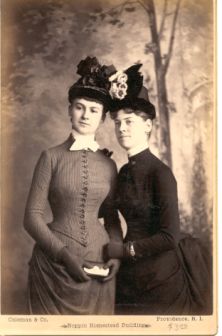Sign up for the Family Tree Newsletter Plus, you’ll receive our 10 Essential Genealogy Research Forms PDF as a special thank you!
Get Your Free Genealogy Forms
"*" indicates required fields
Family memory and photographic evidence don’t always agree. At least that’s true in my experience. While many people e-mail me photographs of completely unknown people, some send in images supposedly identified by a relative. Sometimes the information is correct, but often it’s a case of mistaken identity.
Ken Gibilisco writes, “The photo, we hope, is my great-grandmother, who was born in 1861, and died in 1894 of typhoid fever. In 1945, our grandmother, her oldest daughter, told everyone this is a photo of her mother. Can you shed a little light on this for us? The photo would have had to be taken in the 1880s in Philadelphia, Pa. because she appears to be in her very early twenties.”
I wish I could agree with Ken, but the clothing clues don’t confirm the identification. This young woman is in her mid to late teens. She’s wearing a high-collared three-piece outfit—blouse, skirt, and jacket. It wasn’t taken in the 1880s, when bustles and large button-front bodices were common (see an example of 1880s outfits in the second photo).
Gibilisco’s photograph dates from about 1905. The evidence is in the puffed shoulder and full upper sleeve as well as the pouched blouse front. The girl’s hairstyle with the large bow in back was worn by teenagers and young children prior to 1910.
Gibilsco asked if there was a reason for this portrait. His family only visited photographers for special occasions. It is not, as he hoped, a picture of his great-grandmother taken prior to her wedding in 1881. Instead, it could be this young woman’s graduation photo.
Photographs get misidentified for many reasons, including faulty memory and family resemblances. Perhaps this person resembles the relative who died in 1894. The moral in this tale is simple: Never accept an identification, even handwritten captions, without double-checking the facts. Answer these questions when evaluating a photo:
- Do the clothing clues match the appropriate date for the picture? Use costume encyclopedias like Joan Severa’s Dressed for the Photographer (Kent State University Press, $60).
- Do the photographer’s work dates agree with the tentative identification? Establish a time frame for the photographer’s studio by tracing them in city directories.
- Do the subject’s’s age, clothing clues and photographer’s data match the life dates for the person tentatively identified? Consult your genealogical research to see if there are any other possible identifications for the photo in question.
It’s easy to jump to conclusions and accept a person’s ID or a handwritten caption but both can be wrong. A person’s memory can be spotty and a label incorrect because it was written years after the picture was taken. Use these three do’s to avoid making a don’t—a misidentified family photo. <!–
2000–>
ADVERTISEMENT


